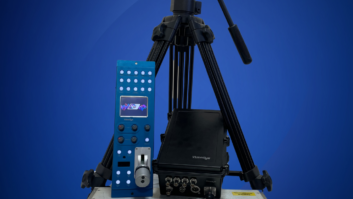German producer and technology developer Telcast Media Group is rolling out a unique camera rig for news, documentary or lifestyle productions that allows one operator to control two cameras. DoubleCam features two miniature Sony XC-555P cameras, one facing the reporter/operator and one camera for the interviewee or point of view action shot. Two Sennheiser ME-36 mics capture audio and lighting is via two LED rings. Including battery the unit weighs just 11kg, writes Adrian Pennington.
“With this technology you can effectively replace two camera crews with one operator and halve production costs,” claims Telcast CEO and president, Thomas Hohenacker.
The operator can cut between each camera using a small handset while viewing what they are recording on a portable front-mounted screen. Up to 100 minutes of MPEG2 can be recorded to 4GB memory sticks or video can be transmitted live by wireless connection for satellite uplink.
“It represents the next stage after video journalism,” says Hohenacker. “The reporter now actively becomes a character involved in the production. Costs are saved because there is no need for an external ENG unit and no need for post production because the feed is already mixed, live, on location.”
In Germany Telcast is putting together a network of DoubleCam operators each covering a 75km area with the intention of beating local broadcast news crews to stories for upload to the internet.
The device has been two years in development. Telcast has already sold models to Chinese and Indian broadcasters but expects most business to come from joint-venture projects. An HD version is also being developed.







